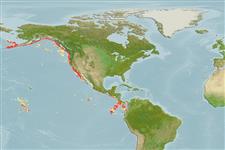Environment: milieu / climate zone / depth range / distribution range
Ecology
Marine; bathydemersal; depth range 294 - 1800 m (Ref. 58496). Deep-water
North Pacific: off Commander Islands, central Bering Sea, off Unalaska Island, western Gulf of Alaska, northern British Columbiai to southern California, USA.
Size / Weight / Age
Maturity: Lm ? range ? - ? cm
Max length : 8.2 cm SL male/unsexed; (Ref. 26773); 8.4 cm SL (female)
Dorsal spines (total): 0; Dorsal soft rays (total): 50 - 57; Anal spines: 0; Anal soft rays: 44 - 51; Vertebrae: 57 - 63. Pectoral fin deeply notched (Ref. 26773). Skin transparent; musculature pale, with scattered melanophores, especially dense near dorsal and anal fin base; mouth pale or light tan; gill cavity blackish; peritoneum and stomach black; pyloric caeca pale (Ref. 26773).
Minimum depth reported at 294 m (Ref. 50610).
Life cycle and mating behavior
Maturities | Reproduction | Spawnings | Egg(s) | Fecundities | Larvae
Stein, D.L., 1978. A review of the deepwater Liparidae (Pisces) from the coast of Oregon and adjacent waters. Proc. Cal. Acad. Sci. 127:1-55. (Ref. 26773)
IUCN Red List Status (Ref. 130435)
Threat to humans
Harmless
Human uses
Tools
Special reports
Download XML
Internet sources
Estimates based on models
Preferred temperature (Ref.
123201): 3.1 - 5.7, mean 4.3 °C (based on 72 cells).
Phylogenetic diversity index (Ref.
82804): PD
50 = 0.5000 [Uniqueness, from 0.5 = low to 2.0 = high].
Bayesian length-weight: a=0.00525 (0.00237 - 0.01161), b=3.15 (2.96 - 3.34), in cm total length, based on LWR estimates for this (Sub)family-body shape (Ref.
93245).
Trophic level (Ref.
69278): 3.4 ±0.5 se; based on size and trophs of closest relatives
Resilience (Ref.
120179): High, minimum population doubling time less than 15 months (Preliminary K or Fecundity.).
Fishing Vulnerability (Ref.
59153): Low vulnerability (10 of 100).
